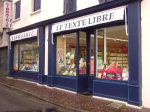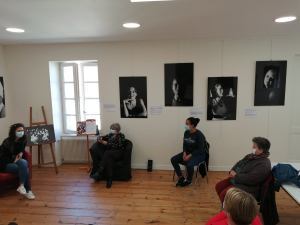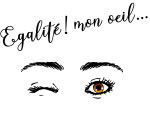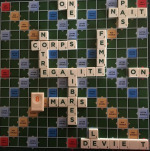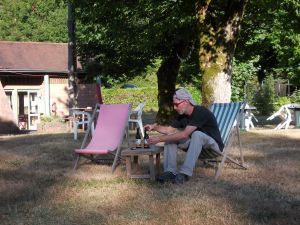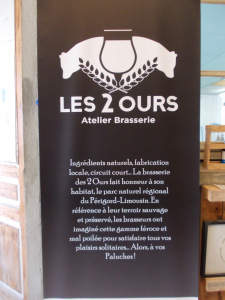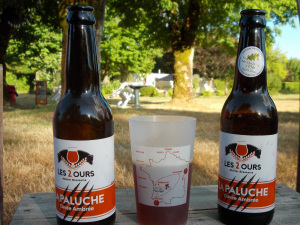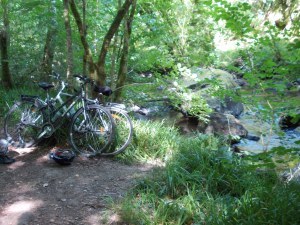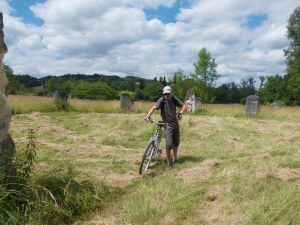Harriet Springbett's Blog, page 4
March 25, 2021
Welcome to Tree Sacrifice
I’m excited to announce that the third book in the Tree Magic series will be published by Impress Books on 7th September 2021 in both e-book and paperback formats.
Please give a warm welcome to Tree Sacrifice.
This is the final book in the trilogy, which begins with Tree Magic and is followed by Tree Slayer. I had such fun finishing Rainbow’s story. I hope you enjoy reading it.
The story is set in France and the UK – and also in a parallel world where trees and people live in harmony. That’s all I’ll say for now, but you’ll find a full blurb at the bottom of the page. If you haven’t read Tree Slayer yet, I suggest you skip the blurb (and that you read Tree Slayer before 7th September!). Some reviewers have said Tree Sacrifice is the best book yet in the series.
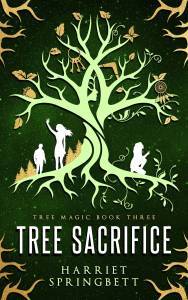 The cover was designed by Molly Phipps, who has done an excellent job, once again – many thanks for the colour suggestions from my readers, which I passed on to my publisher.
The cover was designed by Molly Phipps, who has done an excellent job, once again – many thanks for the colour suggestions from my readers, which I passed on to my publisher.
You can already pre-order the book from your favourite bookseller, and even from your less favourite bookseller if you don’t have an alternative. The ISBN numbers are:
– Tree Sacrifice paperback: 978-1911293705
– Tree Sacrifice e-book: 9781911293699
(The ASIN code for the kindle version of the e-book on Amazon is B08X4Y1YKK )
Pre-orders are really important to authors because the publisher’s marketing budget is often allocated according to the number – lots of pre-orders means that the book will have a bigger budget and reach more people.
Here are some direct links to take you to the three-book series on Amazon: Amazon UK, Amazon France, Amazon USA
Finally, I’d like to thank you for supporting me. To show your appreciation for the years of work involved in each book, it would be great if you could leave comments on Amazon or Goodreads, share posts about the books on social media, talk about them to friends and ask your local library to order copies.
Here’s the blurb:
Tree Sacrifice
A suicide pact. A new responsibility. A desperate bid for harmony.
As Rainbow leaves Brocéliande forest after the events of Tree Slayer, she learns that a much greater challenge faces her. Exasperated by mankind’s disrespect for trees, the One Tree has set a terrible event into motion. Rainbow is strictly forbidden from intervening, but all the trees in France could die unless she does so.
Her search for guidance will take her to England, where a startling discovery makes sense of her gift and opens new perspectives. She must take the hardest decision of her life. But will her and Eole’s sacrifices be enough to save the French forests?
Unknown to Rainbow, help is close by. But it lies in a different world, a parallel world where mankind lives in unity with trees. There, Druana must decide whether she’s prepared to risk everything to rebalance her world.
Will Druana and Rainbow ever meet? What would be the cost? For everything gained, something must be lost.
***
March 16, 2021
Hidden Culture
I have a secret to tell you. What’s more, it’s a secret you can share with others.
Aren’t those kinds of secret the best? They’re the ones where you beckon your friends close, whisper in their ears and then nod smugly at their surprise. They ask more questions, to which only YOU know the answer – you are the star of the moment.
Let’s not get carried away.
My secret involves an independent bookshop in Cognac called Le Texte Libre. Although the place itself isn’t a secret, I bet you don’t know what actually happens there. I certainly didn’t, not until I became a volunteer.
Because – come on, bend closer so you can hear properly – Le Texte Libre isn’t a business whose aim is to make money and get rich (I could mention Ama*** in comparison, but I won’t). It’s actually a not-for-profit association that does far more than sell books.
See? You weren’t aware of that, were you? And now you’re dying to know what else happens in this mysterious old building on the corner of the street between the Camille Godard car park and Place François I in the centre of the town.
A few years ago, the association that runs Le Texte Libre – an association that is committed to raising awareness of societal issues – decided to renovate the dingy upstairs rooms. They transformed them into a beautiful, luminous open space, perfect for…
Well, perfect for lots of things, which is why is was such a great decision.
For example, there is always a free art exhibition of excellent quality in place. It changes regularly, which means that each time you come to Cognac you can pop in, climb the stairs and admire the sculptures, photographs or paintings on display – for free.
This is a welcome diversion, not only from shopping but also in the current Covid context, where access to so many forms of culture is restricted.
Le Texte Libre also organises free events. Authors and artists visit and talk to the public about their work (including famous people like Isabelle Autissier). The association pairs up with local festivals – such as the forthcoming Mars Planet Danse and the European Literature festival – to host meetings with dancers, film directors, actors etc. And they have regular discussion events, such as gatherings to talk about books. They also arrange writing workshops.
Last weekend, I spent all of Saturday there. What joy, to be able to interact with real people rather than a screen!
Given it was International Women’s Day on 8th March, there was (there still is) an exhibition on portraits of women. The photos are accompanied by their accounts of being women in France and elsewhere in the 21st century. Its title is Egalité! Mon Oeil (Equality! My Foot). The oral narratives are available via a flashcode on your mobile phone, to listen to while you admire Albane de Roffignac’s photographs.
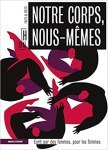 This exhibition was the backdrop to a morning session with Nina Faure, one of the nine authors of a book called Notre corps, Nous-mêmes. This may sound familiar to you. It’s an updated, French version of the women’s health guide Our Bodies, Ourselves written by a Boston women’s collective in the 1970s.
This exhibition was the backdrop to a morning session with Nina Faure, one of the nine authors of a book called Notre corps, Nous-mêmes. This may sound familiar to you. It’s an updated, French version of the women’s health guide Our Bodies, Ourselves written by a Boston women’s collective in the 1970s.
The session with Nina was a Covid-compliant physical encounter for a limited number of people but also a video conference for a wider audience.
It was brilliant. It has changed the way I think about women’s place in society.
Our heads buzzing from new ideas, several of us continued in the afternoon with a writing workshop led by biographer and women’s rights activist, Christine Clamens.
I think I now have the basis for a new novel! Or two. Or three.
My experience last weekend is typical of the kind of culture accessible at Le Texte Libre to anyone interested. It’s free, thought provoking and is a wonderful way to learn and share perspectives with others.
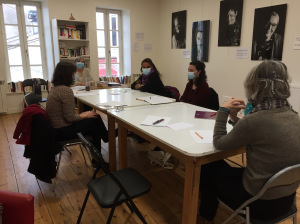 In fact, I’ll be leading a writing workshop there on 5th June. It is aimed at French people who would like to try writing creatively in English, though English speakers will also be welcome. If you know of anyone likely to enjoy this, please tell them to reserve their place via Le Texte Libre (contact details below).
In fact, I’ll be leading a writing workshop there on 5th June. It is aimed at French people who would like to try writing creatively in English, though English speakers will also be welcome. If you know of anyone likely to enjoy this, please tell them to reserve their place via Le Texte Libre (contact details below).
While I’m on the subject of my work, Le Texte Libre also stocks English books, including Tree Magic and Tree Slayer.
They hold an extensive range of French books including children’s, graphic novels, mangas and non-fiction books on environmental, political and social issues. The bookshop is also part of the Nouvelle Aquitaine Independent Bookshops network (LINA).
For information about events at Le Texte Libre, you can consult their facebook page. Better still, you can sign up to their monthly newsletter here. Reservations are usually necessary for events – tel 05 45 32 20 52 – because they are popular.
Yes, they are popular, especially among the elite few, like you, who now know the secret of what happens upstairs at Le Texte Libre.
January 11, 2021
APT 6. Teas and Trees
(Dordogne Cycle Touring 6/6):
A visit to the upper Dronne isn’t complete without a visit to Brantôme – or so the friendly locals in the village bar at St.Pardoux-la-Rivière told us.
It didn’t look too far, so we decided to follow their advice and cycle there the next day, taking only small roads, as usual. An idyllic lane ran parallel to the river on the far side of the main road. It was perfect cycling territory and we even took chances on some tracks. This Abandoned Parent Training (APT) was heavenly!
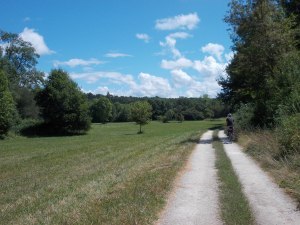
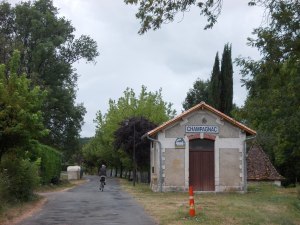
Brantôme, like many picturesque towns in summer, was crowded with tourists. Despite this, it was worth the visit.
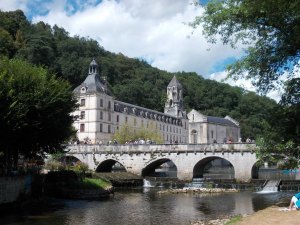
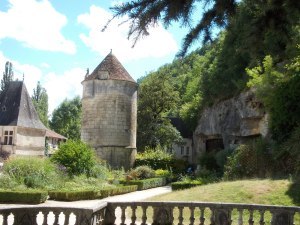
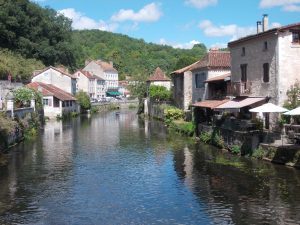
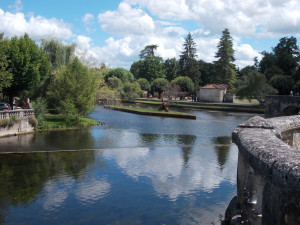
It’s the kind of place you want to visit on a crisp, winter’s day. In fact I’ll definitely be going back this winter because I found treasure there.
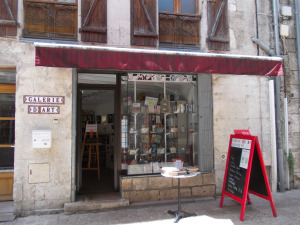 My treasure was a little shop called BookStop. It sells English books, holds art exhibitions, hosts visiting authors and even an English writing group.
My treasure was a little shop called BookStop. It sells English books, holds art exhibitions, hosts visiting authors and even an English writing group.
Best of all, given the morning’s cycling, it has a tea room. The owner, Howard, was serving tea in its little garden overlooking the river. Not any old tea: cream tea! Along with fish’n’chips, cream teas are one of the things I miss about the UK.
Howard’s cream tea was delicious and I loved the British feel of the garden. If you’re in Brantôme, call into 19 rue Victor Hugo and say ‘Hi’ to Howard.
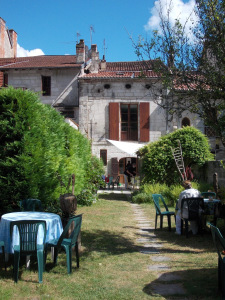
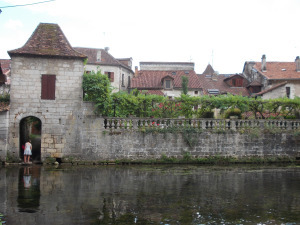
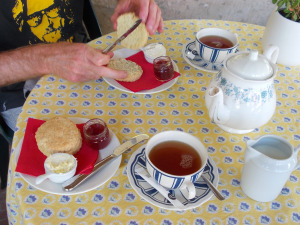
To vary the return cycle ride from Brantôme, we decided to take a series of lanes a little higher in the hills. Our large-scale map didn’t show all the roads but, luckily, my partner navigates with the sun and the lie of the land, (meaning that when the sun sets it’s night and that downhill is towards the river) so I knew we’d be fine.
It was hilly but we were here to train. And then it was even hillier and the sun didn’t seem to be in the right place. There was a distinct lack of roads heading in the direction we wanted. The tracks didn’t lead anywhere either.
At last, we arrived at the campsite, exhausted, with 56.1km on our counter.
Luckily, the two bears were having a party that evening, which meant there were at least six of them waiting for us.
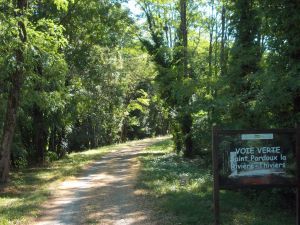 The highlight of the following day again revolved around refreshment. It was hot so we headed along the cycle track to Thiviers, stopping for lunch at St.Jean-de-Côle along the way.
The highlight of the following day again revolved around refreshment. It was hot so we headed along the cycle track to Thiviers, stopping for lunch at St.Jean-de-Côle along the way.
We found the former railway line rather boring because there weren’t many unexpected sights. Thiviers, at the end of the line, was a disappointment too.
But St.Jean-de-Côle was stunning! With its rustic buildings, car-free centre (almost), narrow alleys and roman bridge, it’s a village stuck in a time warp.


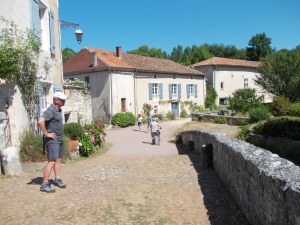
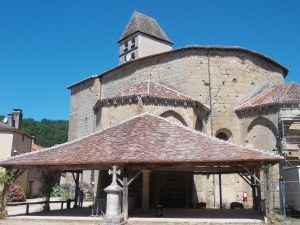
We were charmed by the setting of a restaurant called Le Temps des Mets and decided to treat ourselves to lunch there. The tables are on the village green under plane trees and the quality of food was excellent.
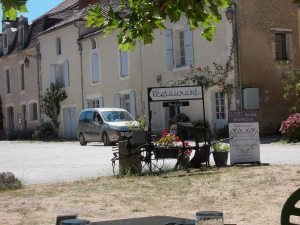
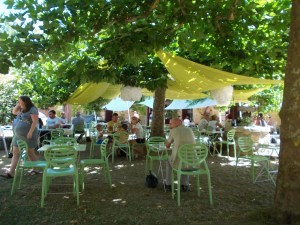
Restaurant lunches were something we’d rarely done before, and we certainly couldn’t have afforded it with the kids in tow. You see how our APT senses were sharpening? Thanks to days of hard training, we were finding new possibilities.
Our last day of training took us northeast, with an attempt to find a passage across the River Dronne upstream of the unimpressive Saut du Chalard. We gave up when the track turned into brambles and tree stumps. Our circuit took us past the Arboretum de Montagnac, so we stopped for some contemplative tree-bathing before heading back to the campsite to pack up.
We had successfully spent four days without contacting the kids and had hardly even thought about them. OK, that last part is a lie, since they featured largely in our conversations. Still, I felt fully qualified in APT, ready to become an Abandoned Parent at the beginning of September. My partner and I would join a rock-climbing club. We would cycle together. We would eat at restaurants and leave on long camping weekends to discover new guinguettes and local breweries.
Our car packed, I phoned my daughters to tell them we’d soon be home. It was only fair to give them some warning so they could lay the table and demonstrate the life skills they’d learnt during our absence.
“Oh good,” said my youngest.
I was pleased to know we’d been missed – until she added that her older sister had a fever and was in bed.
We jumped in the car and raced home (though we did stop to buy a few boxes of Two Bear beers).
We were ready to be abandoned, but abandoning our children was a different matter.
***
Thank you for following my cycle touring ‘adventures’ in the Dronne valley.
If you enjoyed them, you may like to read about my ‘Doorstep Cycling’ trip along the River Charente, which you can find here, or my ‘Writing Residency’ experience discovering the Val d’Azun in the Pyrenees mountains here.
Teas and Trees
(Dordogne Cycle Touring 6/6):
A visit to the upper Dronne isn’t complete without a visit to Brantôme – or so the friendly locals in the village bar at St.Pardoux-la-Rivière told us.
It didn’t look too far, so we decided to follow their advice and cycle there the next day, taking only small roads, as usual. An idyllic lane ran parallel to the river on the far side of the main road. It was perfect cycling territory and we even took chances on some tracks. This Abandoned Parent Training (APT) was heavenly!


Brantôme, like many picturesque towns in summer, was crowded with tourists. Despite this, it was worth the visit.




It’s the kind of place you want to visit on a crisp, winter’s day. In fact I’ll definitely be going back this winter because I found treasure there.
 My treasure was a little shop called BookStop. It sells English books, holds art exhibitions, hosts visiting authors and even an English writing group.
My treasure was a little shop called BookStop. It sells English books, holds art exhibitions, hosts visiting authors and even an English writing group.
Best of all, given the morning’s cycling, it has a tea room. The owner, Howard, was serving tea in its little garden overlooking the river. Not any old tea: cream tea! Along with fish’n’chips, cream teas are one of the things I miss about the UK.
Howard’s cream tea was delicious and I loved the British feel of the garden. If you’re in Brantôme, call into 19 rue Victor Hugo and say ‘Hi’ to Howard.



To vary the return cycle ride from Brantôme, we decided to take a series of lanes a little higher in the hills. Our large-scale map didn’t show all the roads but, luckily, my partner navigates with the sun and the lie of the land, (meaning that when the sun sets it’s night and that downhill is towards the river) so I knew we’d be fine.
It was hilly but we were here to train. And then it was even hillier and the sun didn’t seem to be in the right place. There was a distinct lack of roads heading in the direction we wanted. The tracks didn’t lead anywhere either.
At last, we arrived at the campsite, exhausted, with 56.1km on our counter.
Luckily, the two bears were having a party that evening, which meant there were at least six of them waiting for us.
 The highlight of the following day again revolved around refreshment. It was hot so we headed along the cycle track to Thiviers, stopping for lunch at St.Jean-de-Côle along the way.
The highlight of the following day again revolved around refreshment. It was hot so we headed along the cycle track to Thiviers, stopping for lunch at St.Jean-de-Côle along the way.
We found the former railway line rather boring because there weren’t many unexpected sights. Thiviers, at the end of the line, was a disappointment too.
But St.Jean-de-Côle was stunning! With its rustic buildings, car-free centre (almost), narrow alleys and roman bridge, it’s a village stuck in a time warp.




We were charmed by the setting of a restaurant called Le Temps des Mets and decided to treat ourselves to lunch there. The tables are on the village green under plane trees and the quality of food was excellent.


Restaurant lunches were something we’d rarely done before, and we certainly couldn’t have afforded it with the kids in tow. You see how our APT senses were sharpening? Thanks to days of hard training, we were finding new possibilities.
Our last day of training took us northeast, with an attempt to find a passage across the River Dronne upstream of the unimpressive Saut du Chalard. We gave up when the track turned into brambles and tree stumps. Our circuit took us past the Arboretum de Montagnac, so we stopped for some contemplative tree-bathing before heading back to the campsite to pack up.
We had successfully spent four days without contacting the kids and had hardly even thought about them. OK, that last part is a lie, since they featured largely in our conversations. Still, I felt fully qualified in APT, ready to become an Abandoned Parent at the beginning of September. My partner and I would join a rock-climbing club. We would cycle together. We would eat at restaurants and leave on long camping weekends to discover new guinguettes and local breweries.
Our car packed, I phoned my daughters to tell them we’d soon be home. It was only fair to give them some warning so they could lay the table and demonstrate the life skills they’d learnt during our absence.
“Oh good,” said my youngest.
I was pleased to know we’d been missed – until she added that her older sister had a fever and was in bed.
We jumped in the car and raced home (though we did stop to buy a few boxes of Two Bear beers).
We were ready to be abandoned, but abandoning our children was a different matter.
***
Thank you for following my cycle touring ‘adventures’ in the Dronne valley.
If you enjoyed them, you may like to read about my ‘Doorstep Cycling’ trip along the River Charente, which you can find here, or my ‘Writing Residency’ experience discovering the Val d’Azun in the Pyrenees mountains here.
January 10, 2021
APT 5. The Two Bears
(Dordogne Cycle Touring 5/6):
Our weekend at Lisle in June was a great start to learning to be a couple again, having been parents for 20 years. We considered it so useful in terms of Abandoned Parent Training (APT) that when we had the chance to progress further via a second APT weekend, we seized the opportunity.
This time, we would do it in style. For starters, we’d leave for four days instead of two, and we’d take our roomy teepee rather than the little tent we use for party sleepovers. Our daughters were busy with their summer jobs and claimed they’d hardly notice our absence. I’m sure they were just being brave and would miss us terribly.
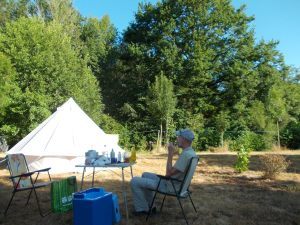 Without the kids’ belongings, the car seemed empty, so we found some items of comfort to fill it – such as a folding table and deck chairs – as well as our bikes. We were cycle touring on a different level to our week in the Charente in 2019, when we’d been towing a bike trailer.
Without the kids’ belongings, the car seemed empty, so we found some items of comfort to fill it – such as a folding table and deck chairs – as well as our bikes. We were cycle touring on a different level to our week in the Charente in 2019, when we’d been towing a bike trailer.
We decided to discover the River Dronne upstream of Bourdeilles. The village of St.Pardoux-la-Rivière seemed a good base because, as a meeting place of five roads, it would give us five different directions to explore.
When we arrived, we discovered that the village was perfect. Not only did it have the necessary shops and a market, but it also boasted access to the Flow Vélo cycle route along the former railway line to Thiviers.
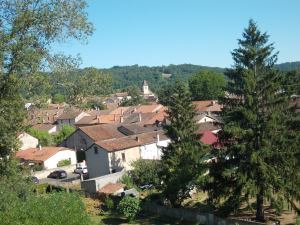
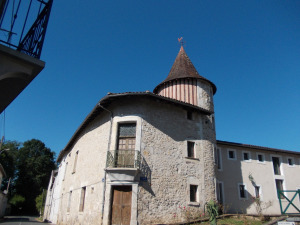
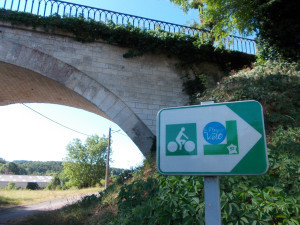
The campsite, La Font Pissole, was perfect too. Quiet and friendly, it sold the local beer made by ‘Les 2 Ours’ (The Two Bears) brewery at Nontron.
Keen to cycle (rather than falling into a guinguette trap), I suggested we begin as soon as our tent was pitched. So, at 4pm we left the campsite and headed towards a landmark on the map that intrigued my partner: the Saut du Chalard.
“A saut is a kind of waterfall,” he told me. I’d already translated saut as a jump, and now I envisioned a steep hillside with a dramatic waterfall and a ledge at the top from which someone called Monsieur Chalard must have jumped or fallen. The local legend would be described in detail on one of those information panels I like so much.
The day had been hot, and although the first five kilometres were uphill, it was shady and we even saw deer in the woodland. We passed an unlikely wedding group in the tiny village of Champs-Romain, and this, coupled with a bagpipe-player blowing his heart out in the middle of a field near the cemetery, made us wonder whether we’d ventured onto a film set.
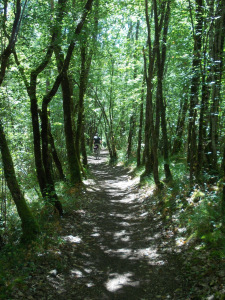 The footpath sign to the Saut du Chalard indicated a 1.5-hour walk and a 100m descent. I was a little surprised that we would view the waterfall from the bottom, rather than the narrow ledge at the top. But perhaps we’d be able to walk behind it, like in those Enid Blyton adventure stories.
The footpath sign to the Saut du Chalard indicated a 1.5-hour walk and a 100m descent. I was a little surprised that we would view the waterfall from the bottom, rather than the narrow ledge at the top. But perhaps we’d be able to walk behind it, like in those Enid Blyton adventure stories.
“Is the path suitable for bikes?” I asked a family returning on foot from the waterfall. They assured me it was.
It was suitable, to begin with. But it soon became obvious that we’d have to dismount if we wanted to spend the weekend cycling rather than nursing broken limbs in hospital. Or maybe that was because we took the wrong path at the fork? Anyway, it didn’t matter that we’d have to push our bikes back up the steep hill afterwards. The sight would be worth it.
The young River Dronne, when we reached it, was as impatient as a mountain stream. There was a good bathing spot with a little rush of water about a metre high between two rounded boulders, making a jacuzzi pool (you can see some photos at the bottom of this page here). I put down my bike and started to walk along the riverbank.
“Where are you going?” my partner asked.
“To find the waterfall. It’s probably upstream,” I said.
When he gave me a sideways look, I realised I’d miscalculated.
“This is the waterfall,” he said. “It’s a saut, a jump, not a chute, a fall.”
That was it: no narrow ledge. No information panel. No broken-hearted Monsieur Chalard jumping to his death in despair.
However, we did complete 16.6km, a record for a couple of hours’ cycling.
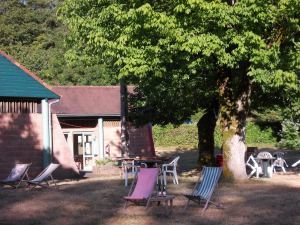 Best of all, when we returned to the campsite, there were two cold beers (or two cold bears) and two deck chairs awaiting us.
Best of all, when we returned to the campsite, there were two cold beers (or two cold bears) and two deck chairs awaiting us.
That was the point I realised that what I love about cycle touring is the arrival, the moment you can refresh yourself with local beer and reflect on the day’s highs and lows.
Carrying the logic of that idea further, did we have to wait until the end of the bike ride to refresh ourselves? I would test this theory the very next day.
The Two Bears
(Dordogne Cycle Touring 5/6):
Our weekend at Lisle in June was a great start to learning to be a couple again, having been parents for 20 years. We considered it so useful in terms of Abandoned Parent Training (APT) that when we had the chance to progress further via a second APT weekend, we seized the opportunity.
This time, we would do it in style. For starters, we’d leave for four days instead of two, and we’d take our roomy teepee rather than the little tent we use for party sleepovers. Our daughters were busy with their summer jobs and claimed they’d hardly notice our absence. I’m sure they were just being brave and would miss us terribly.
 Without the kids’ belongings, the car seemed empty, so we found some items of comfort to fill it – such as a folding table and deck chairs – as well as our bikes. We were cycle touring on a different level to our week in the Charente in 2019, when we’d been towing a bike trailer.
Without the kids’ belongings, the car seemed empty, so we found some items of comfort to fill it – such as a folding table and deck chairs – as well as our bikes. We were cycle touring on a different level to our week in the Charente in 2019, when we’d been towing a bike trailer.
We decided to discover the River Dronne upstream of Bourdeilles. The village of St.Pardoux-la-Rivière seemed a good base because, as a meeting place of five roads, it would give us five different directions to explore.
When we arrived, we discovered that the village was perfect. Not only did it have the necessary shops and a market, but it also boasted access to the Flow Vélo cycle route along the former railway line to Thiviers.



The campsite, La Font Pissole, was perfect too. Quiet and friendly, it sold the local beer made by ‘Les 2 Ours’ (The Two Bears) brewery at Nontron.
Keen to cycle (rather than falling into a guinguette trap), I suggested we begin as soon as our tent was pitched. So, at 4pm we left the campsite and headed towards a landmark on the map that intrigued my partner: the Saut du Chalard.
“A saut is a kind of waterfall,” he told me. I’d already translated saut as a jump, and now I envisioned a steep hillside with a dramatic waterfall and a ledge at the top from which someone called Monsieur Chalard must have jumped or fallen. The local legend would be described in detail on one of those information panels I like so much.
The day had been hot, and although the first five kilometres were uphill, it was shady and we even saw deer in the woodland. We passed an unlikely wedding group in the tiny village of Champs-Romain, and this, coupled with a bagpipe-player blowing his heart out in the middle of a field near the cemetery, made us wonder whether we’d ventured onto a film set.
 The footpath sign to the Saut du Chalard indicated a 1.5-hour walk and a 100m descent. I was a little surprised that we would view the waterfall from the bottom, rather than the narrow ledge at the top. But perhaps we’d be able to walk behind it, like in those Enid Blyton adventure stories.
The footpath sign to the Saut du Chalard indicated a 1.5-hour walk and a 100m descent. I was a little surprised that we would view the waterfall from the bottom, rather than the narrow ledge at the top. But perhaps we’d be able to walk behind it, like in those Enid Blyton adventure stories.
“Is the path suitable for bikes?” I asked a family returning on foot from the waterfall. They assured me it was.
It was suitable, to begin with. But it soon became obvious that we’d have to dismount if we wanted to spend the weekend cycling rather than nursing broken limbs in hospital. Or maybe that was because we took the wrong path at the fork? Anyway, it didn’t matter that we’d have to push our bikes back up the steep hill afterwards. The sight would be worth it.
The young River Dronne, when we reached it, was as impatient as a mountain stream. There was a good bathing spot with a little rush of water about a metre high between two rounded boulders, making a jacuzzi pool (you can see some photos at the bottom of this page here). I put down my bike and started to walk along the riverbank.
“Where are you going?” my partner asked.
“To find the waterfall. It’s probably upstream,” I said.
When he gave me a sideways look, I realised I’d miscalculated.
“This is the waterfall,” he said. “It’s a saut, a jump, not a chute, a fall.”
That was it: no narrow ledge. No information panel. No broken-hearted Monsieur Chalard jumping to his death in despair.
However, we did complete 16.6km, a record for a couple of hours’ cycling.
 Best of all, when we returned to the campsite, there were two cold beers (or two cold bears) and two deck chairs awaiting us.
Best of all, when we returned to the campsite, there were two cold beers (or two cold bears) and two deck chairs awaiting us.
That was the point I realised that what I love about cycle touring is the arrival, the moment you can refresh yourself with local beer and reflect on the day’s highs and lows.
Carrying the logic of that idea further, did we have to wait until the end of the bike ride to refresh ourselves? I would test this theory the very next day.
January 9, 2021
APT 4. It’s Nuts
(Dordogne Cycle Touring 4/6):
Our first Abandoned Parent Training (APT) weekend could be summed up with the saying ‘All Roads lead to Rénamont’, followed by ‘Especially when my partner is in charge of the map’.
Today, Sunday, I was determined that we would cycle further than yesterday’s 13km, a plan that seemed entirely possible given that we weren’t in the least saddlesore. We had to drive home that evening but most of the day was free for cycle touring.
I took charge, which meant that the tent and most of our belongings were packed into the car before we left for the day’s explorations. Wasn’t that efficient? My plan was to cycle in the opposite direction to Rénamont.
Our circuit took us along more little lanes beside the River Dronne, past plantations of walnuts – which grow everywhere in the area – until we arrived a watermill museum called La Maison de la Dronne near the village of Tocane-St.Apre. We stopped to explore, disappointed to find the exhibition on watermills closed, due to Covid.
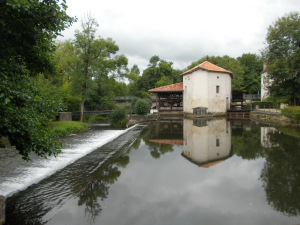
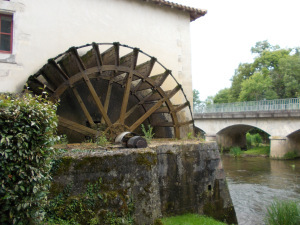
We continued up the hill on the opposite side of the river – a safe distance from Rénamont – and cycled towards the château of Fayolle and its viewpoint across the Dronne valley.
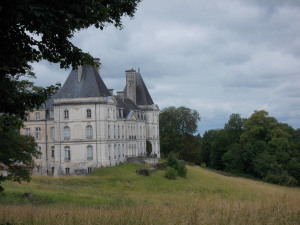 The cycling was pleasant, but we made no interesting discoveries during the ride. So when my partner suggested we abandon the south side of the river and visit the village of Montagrier instead, I agreed.
The cycling was pleasant, but we made no interesting discoveries during the ride. So when my partner suggested we abandon the south side of the river and visit the village of Montagrier instead, I agreed.
Then I looked at the map. Montagrier was dangerously close to Rénamont.
But I was in charge today.
I’m glad we changed routes. Montagrier is a pretty village on a hill, with an outlying church that has a wonderful avenue of plane trees leading to it, coupled with a great view.
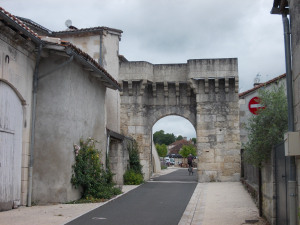
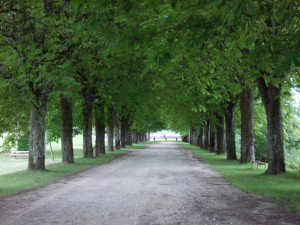
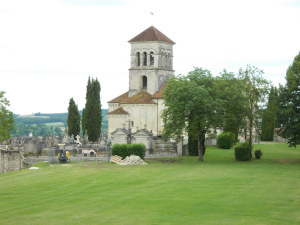
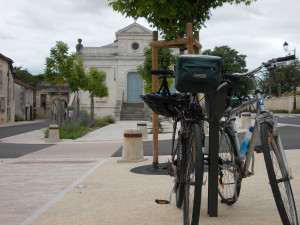
Time was passing and, after a coffee on a terrace in Montagrier, we continued in a loop back towards the campsite. I kept my eye on the map and when we reached the turning to Rénamont, I rode blithely past it. I don’t think my partner noticed the signpost. We even managed to beat the previous day’s 13km by, well, by 8km, making a grand total of 21km for the day. It was lucky we were doing APT and not fitness training.
The gain of time by not stopping at the guinguette meant we had time to visit a walnut farm shop. When we entered the barn, the smell of concentrated walnut was incredible. Even better, the farmer kindly took time to demonstrate his traditional method for making walnut oil.
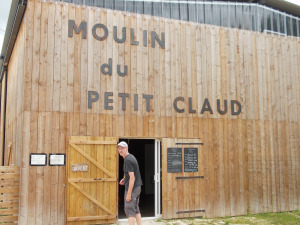
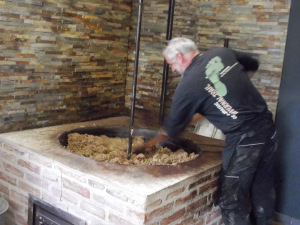
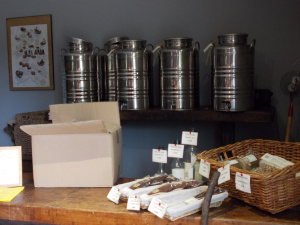
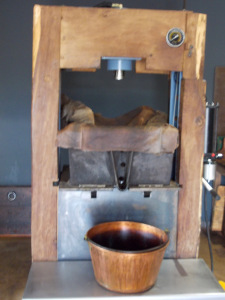
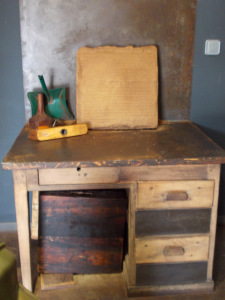
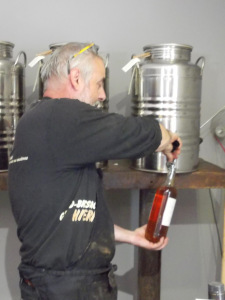
And so it was that, surprisingly, we brought home walnut oil rather than BAM beer. I was expecting our children to be pleased – after all, walnut oil is a wonderful ingredient for cooking. But they seemed disappointed. As for their weekend of practising life skills, their friends must have taken home the results, because there was no sign of a meal waiting for us on our arrival.
Six months later, we still have half a bottle of walnut oil left. Each time I open it, my senses are flooded by memories of our first weekend of APT training at Rénamont Lisle.
As for our second APT weekend, which took place at the end of July 2020, I’ll tell you about that tomorrow.
It’s Nuts
(Dordogne Cycle Touring 4/6):
Our first Abandoned Parent Training (APT) weekend could be summed up with the saying ‘All Roads lead to Rénamont’, followed by ‘Especially when my partner is in charge of the map’.
Today, Sunday, I was determined that we would cycle further than yesterday’s 13km, a plan that seemed entirely possible given that we weren’t in the least saddlesore. We had to drive home that evening but most of the day was free for cycle touring.
I took charge, which meant that the tent and most of our belongings were packed into the car before we left for the day’s explorations. Wasn’t that efficient? My plan was to cycle in the opposite direction to Rénamont.
Our circuit took us along more little lanes beside the River Dronne, past plantations of walnuts – which grow everywhere in the area – until we arrived a watermill museum called La Maison de la Dronne near the village of Tocane-St.Apre. We stopped to explore, disappointed to find the exhibition on watermills closed, due to Covid.


We continued up the hill on the opposite side of the river – a safe distance from Rénamont – and cycled towards the château of Fayolle and its viewpoint across the Dronne valley.
 The cycling was pleasant, but we made no interesting discoveries during the ride. So when my partner suggested we abandon the south side of the river and visit the village of Montagrier instead, I agreed.
The cycling was pleasant, but we made no interesting discoveries during the ride. So when my partner suggested we abandon the south side of the river and visit the village of Montagrier instead, I agreed.
Then I looked at the map. Montagrier was dangerously close to Rénamont.
But I was in charge today.
I’m glad we changed routes. Montagrier is a pretty village on a hill, with an outlying church that has a wonderful avenue of plane trees leading to it, coupled with a great view.




Time was passing and, after a coffee on a terrace in Montagrier, we continued in a loop back towards the campsite. I kept my eye on the map and when we reached the turning to Rénamont, I rode blithely past it. I don’t think my partner noticed the signpost. We even managed to beat the previous day’s 13km by, well, by 8km, making a grand total of 21km for the day. It was lucky we were doing APT and not fitness training.
The gain of time by not stopping at the guinguette meant we had time to visit a walnut farm shop. When we entered the barn, the smell of concentrated walnut was incredible. Even better, the farmer kindly took time to demonstrate his traditional method for making walnut oil.






And so it was that, surprisingly, we brought home walnut oil rather than BAM beer. I was expecting our children to be pleased – after all, walnut oil is a wonderful ingredient for cooking. But they seemed disappointed. As for their weekend of practising life skills, their friends must have taken home the results, because there was no sign of a meal waiting for us on our arrival.
Six months later, we still have half a bottle of walnut oil left. Each time I open it, my senses are flooded by memories of our first weekend of APT training at Rénamont Lisle.
As for our second APT weekend, which took place at the end of July 2020, I’ll tell you about that tomorrow.
January 8, 2021
APT 3. Flowering Cars
(Dordogne Cycle Touring 3/6):
The first full day of our Lisle APT training weekend, Saturday, dawned bright and sunny, perfect for a long day of cycling. We were sure we could beat our 2019 record and manage a hundred kilometres. Today was our best chance, since we weren’t yet saddlesore.
We set off towards Bourdeilles, a riverside village that the people at Rénamont had advised us to visit. There was plenty to admire along the pretty country roads, from a 400-year-old oak tree to a flowering car.
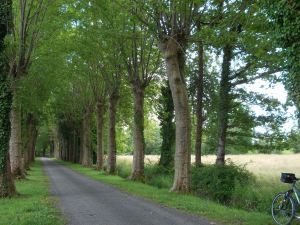
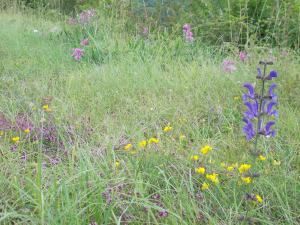
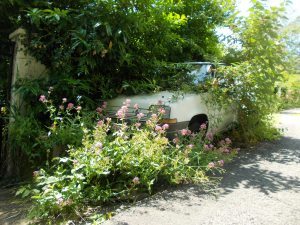
We stopped to ask a gardener whether the wooden building in his garden was a tobacco-drying shed (it was). Half an hour later we were still discussing politics and the environment with him, and had been invited to share an aperitif with his family. It would have been easy to stop there, just 2km from the campsite. But we didn’t. We valiantly continued our journey, fascinated by his self-sufficiency project and glad to have put the world to rights.
Bourdeilles is beautiful and not too big. I recommend a visit if you’re in the area. We cycled through the streets, took photos and generally behaved exactly like the tourists we take pains to avoid.
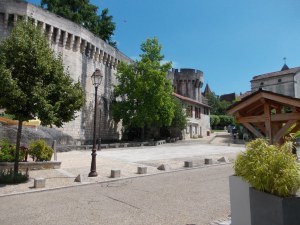
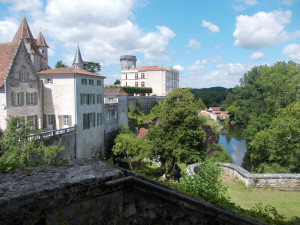
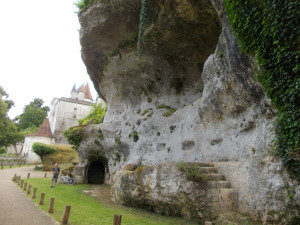
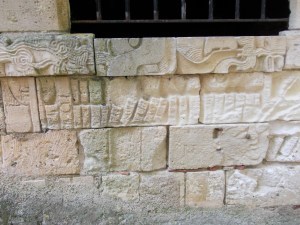
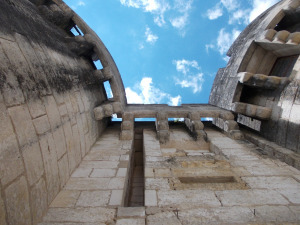
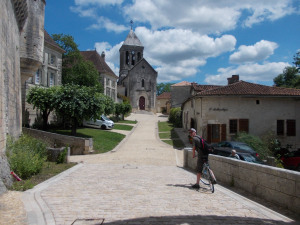
After a quick coffee on a terrace, we continued cycling along the most delightful series of shady lanes. Predictably, I fell in love with rural Dordogne and daydreamed about selling our house and launching ourselves into self-sufficiency here.
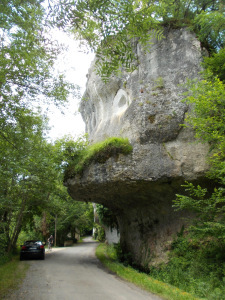
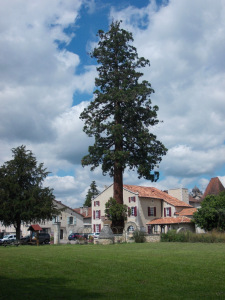
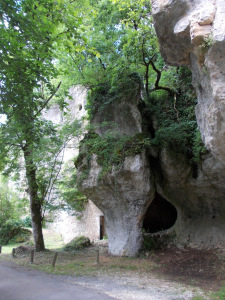
My partner was in charge of the map – not that he seemed to look at it very often. We followed the river, stopping to take photos and caress the overhanging rockfaces, remembering our former passion for rock-climbing. Once our daughters had abandoned us, our evenings would be free! We could join clubs. We could start climbing again.
(You see how well the APT training was working?)
I was a little surprised, after just a few more kilometres, when we turned onto a familiar-looking track and headed down a steep hill.
“Let’s check out the standing stones,” said my partner.
He was referring to a ring of stones we’d spotted the evening before, at the entrance to the Rénamont guinguette.
We waded through long grass and examined the stones, speculating as to their origin.
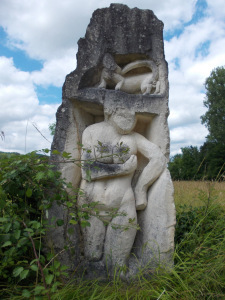
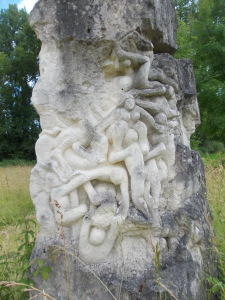
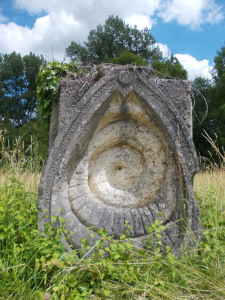
“We could ask about them at the bar,” said my partner.
I saw the gleam in his eyes again, and understood. It was only 3pm and we’d cycled the grand distance of 10km.
“OK,” I agreed.
Six hours later, at dusk – after some games of pétanque, a paddle and walk along the river, a siesta, some convivial aperitifs and an evening meal accompanied by BAM beer – we wobbled our way back to the campsite. We’d only cycled 13km but we’d found a place we knew we’d return to. As for the standing stones, they were installed and sculpted during a festival held on the site.
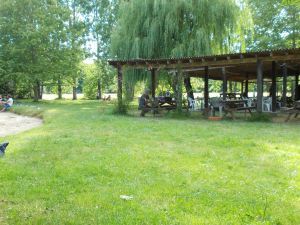
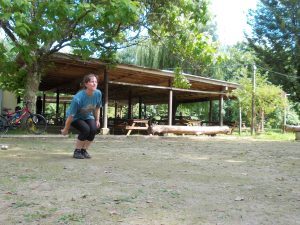
It didn’t matter that we’d done more socialising than cycling. We would rectify that the next day. At least, that’s what we told ourselves.
Flowering Cars
(Dordogne Cycle Touring 3/6):
The first full day of our Lisle APT training weekend, Saturday, dawned bright and sunny, perfect for a long day of cycling. We were sure we could beat our 2019 record and manage a hundred kilometres. Today was our best chance, since we weren’t yet saddlesore.
We set off towards Bourdeilles, a riverside village that the people at Rénamont had advised us to visit. There was plenty to admire along the pretty country roads, from a 400-year-old oak tree to a flowering car.



We stopped to ask a gardener whether the wooden building in his garden was a tobacco-drying shed (it was). Half an hour later we were still discussing politics and the environment with him, and had been invited to share an aperitif with his family. It would have been easy to stop there, just 2km from the campsite. But we didn’t. We valiantly continued our journey, fascinated by his self-sufficiency project and glad to have put the world to rights.
Bourdeilles is beautiful and not too big. I recommend a visit if you’re in the area. We cycled through the streets, took photos and generally behaved exactly like the tourists we take pains to avoid.






After a quick coffee on a terrace, we continued cycling along the most delightful series of shady lanes. Predictably, I fell in love with rural Dordogne and daydreamed about selling our house and launching ourselves into self-sufficiency here.



My partner was in charge of the map – not that he seemed to look at it very often. We followed the river, stopping to take photos and caress the overhanging rockfaces, remembering our former passion for rock-climbing. Once our daughters had abandoned us, our evenings would be free! We could join clubs. We could start climbing again.
(You see how well the APT training was working?)
I was a little surprised, after just a few more kilometres, when we turned onto a familiar-looking track and headed down a steep hill.
“Let’s check out the standing stones,” said my partner.
He was referring to a ring of stones we’d spotted the evening before, at the entrance to the Rénamont guinguette.
We waded through long grass and examined the stones, speculating as to their origin.



“We could ask about them at the bar,” said my partner.
I saw the gleam in his eyes again, and understood. It was only 3pm and we’d cycled the grand distance of 10km.
“OK,” I agreed.
Six hours later, at dusk – after some games of pétanque, a paddle and walk along the river, a siesta, some convivial aperitifs and an evening meal accompanied by BAM beer – we wobbled our way back to the campsite. We’d only cycled 13km but we’d found a place we knew we’d return to. As for the standing stones, they were installed and sculpted during a festival held on the site.


It didn’t matter that we’d done more socialising than cycling. We would rectify that the next day. At least, that’s what we told ourselves.



